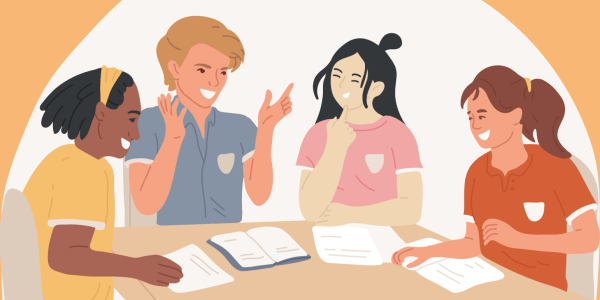CENTERING COMMUNITY VOICE IN RPP WORK THROUGH CIVIC IMAGINATION AND STORYTELLING

INTRODUCTION: “A People of Innovation”
“We come from a people of innovation,” explained Mary Slone, a high school teacher from Floyd County, Kentucky. She shared this reflection after a Civic Imagination Workshop supported by the 3-year National Science Foundation CSforALL Project entitled Drawing on Kinship: Rurally Sustaining Computational Thinking Pathways. Further reflecting on the history of making, innovation, and Appalachian Ingenuity in the community, Mary continued, “we were reminded there were people before us who had all these wonderful skills…they inspire me.”
Mary was one of 18 teachers from two Eastern Kentucky school districts who shared their experiences during the Civic Imagination Workshop as part of the Drawing on Kinship research-practice partnership (RPP). Hosted in February 2023, this workshop kicked-off our project that aims to expand rural students’ understanding of computational thinking through lessons that are connected to local heritages of problem solving. In order to design such lessons, it was important for teachers – who will be designing these project-based lessons – to explore such heritages and imagine how these may relate to innovation and problem-solving using computing. Most of the teachers had taught computational thinking through our previous RPP, Tough as Nails, Nimble Fingers, but had not connected these competencies to their or their students’ cultures.
Thus, the Civic Imagination Workshop featured teachers’ storytelling about Appalachian Ingenuity, a concept introduced to us by our practice-side partners that is tied to the history of making and survival in the Appalachian region of Eastern Kentucky. Stories of Appalachian Ingenuity we’ve heard so far are characterized by perseverance, selflessness, collaboration, resourcefulness, agency, and pragmatism. We imagined that these stories would specifically feature components of computational thinking, such as working with data and automation.
In this article, we dive into how civic imagination and storytelling showed up in our RPP and share what we learned about the important role both of these concepts might play in RPP work more generally, in particular as they relate to meaningfully bringing community voice into RPP work, beginning with the stories of practice-side partners who are part of the local community.
THE ROLE OF CIVIC IMAGINATION AND STORYTELLING IN OUR RPP
Defining Civic Imagination
The University of Southern California’s Civic Imagination Project defines civic imagination as a way of shaping a vision for the future through the uniquely human capacity for storytelling. Sam Ford, Executive Director of AccelerateKY who led our civic imagination workshop, works with the Civic Imagination Project and summarizes civic imagination as:
- People can’t work toward a future if they can’t see it first
- People don’t want to design a future that they aren’t in
- People need to feel a sense of agency or permission to help shape that future
These tenets of civic imagination have grounded the design of our early RPP work and the Civic Imagination Workshop.
Civic Imagination in Action: Teachers Share Their Stories
As a Kentuckian with a journalism background, Sam Ford knows the roots and importance of storytelling in the community. At the workshop, Sam invited each teacher to bring a physical object that represents the history of Appalachian Ingenuity and share the story of their object (visit our project website to hear teacher stories and see some of their objects). This object sharing brought teachers into the project by providing space for them to share their own stories, often stories of innovators in their families, and to use their voice to share what is powerful and unique about their community and Appalachian Ingenuity. Generally, the stories recollected positive memories that the teachers were willing to share with others. They shared unique and innovative ways that family members added height to a stool using scrap lumber, scared away hornets using a faux nest, and preserved food with mason jars. Teachers also shared skills they learned from their parents and grandparents, like quilting, and innovation around family activities like car racing. As the storytelling went on, teachers built upon what others had shared and found commonalities between their stories like mason jars and race days. As Mary Slone shared in her blog post based on the workshop, “each story was a reminder that I, along with my peers, have borne witness and been impacted by makers–people who live on the edge of disruption and choose to use it as an agent.”

Figure 1. Examples of shared objects from the civic imagination workshop: (a) a stool with added height from scrap lumber, (b) a faux hornets nest hung on the porch, (c) a quilt with coal miners on the quilt blocks (photos courtesy of workshop participants)
Sharing stories provided a chance for the teachers to make a bridge between the past and the present. From there, the teachers looked to the future – a future that supports students to celebrate and develop the ingenuity of their Appalachian heritage. The teachers began to imagine the future of their community in Eastern Kentucky, where they hope it will be in 30 years, and what storytelling can do in their classroom. Civic imagination gave teachers the opportunity to voice stories from the past to imagine and design their future.
The Importance of Storytelling in our Research
How are storytelling and Appalachian Ingenuity stories related to computational thinking education research? Initially, we hypothesized that local and cultural innovation stories could provide clear, compelling, and relatable examples of computational thinking, thus facilitating understanding for teachers and students. We believed that showcasing Appalachian instances of computational thinking skills and practices would help students learn in a way that aligns with their identity and values.
However, during our initial process of collecting and analyzing stories for computational thinking (Iwatani, Coenraad, Arnett & Tackett, 2023), and developing the summer curriculum design workshop for teachers, we encountered challenges. Many innovation and ingenuity stories did not naturally exhibit the computational thinking practices emphasized in the Kentucky Academic Standards. Furthermore, even if some computational thinking practices were present in certain innovations, they might not be the most captivating aspects of the storytelling. We also found it difficult to imagine a curriculum design teacher workshop that effectively integrates ingenuity storytelling with computational thinking. How can we convincingly explain to teachers that ancestral stories about food preservation for the winter can enhance students’ understanding of computational thinking?
In the true spirit of RPP, our research-side and practice-side collaborative team engaged in a series of large and small-group meetings to address the conceptual issues we observed. A moment of clarity arose when we revisited the fundamental goals of our project. Eastern Kentucky educators and elders want students to be inspired to engage in general problem-solving, which strongly connects to local ingenuity and storytelling. On the other hand, computational thinking represents a specific set of technical skills that we believe will benefit students in solving various contemporary problems. These skills are a narrow subset of general “problem-solving” or “ingenuity,” and therefore, it is neither necessary, expected, nor crucial for all instances of Appalachian ingenuity and innovation to involve computational thinking.
Building on this realization, our project now comprehends the significance of ingenuity and innovation stories for both research and practice. We have identified reasons to share with our storytellers, educators, students, and research colleagues, illustrating why these stories hold importance:
- We want examples of local problem-solving and innovation that middle school students in Eastern Kentucky might find interesting. These examples can inspire students to solve problems in their own lives and their communities.
- We’re looking for real-world challenges that are close-to-home for middle school students in Eastern Kentucky. We believe that these students have creativity and resourcefulness to help find solutions to these challenges.
- We are curious about whether anything similar to (what we today call) computational thinking skills have been used in the community and its history. Exploring this connection could provide helpful examples for students as they learn these skills themselves.
- We aim to create a collection of resources that students and teachers can easily access and use during project-based learning. These resources will provide guidance and support throughout their projects.
- We want to develop storytelling models and methods for educators and students, especially to support students to become better communicators. These models may encourage them to connect with their families and communities. They may also enhance student learning through community involvement, and inform community members about the interests and skills of today’s students.
The principles of civic imagination played a vital role in our RPP as we sought clarity in the relationship between computational thinking and Appalachian Ingenuity. To work towards a shared vision of the future, we engaged in extensive discussions and reflection to define this connection, acknowledging the importance of having a clear direction. We ensured that the relevance of computational thinking and Appalachian Ingenuity was recognized by both research-side and practice-side partners (including district leaders and teachers), valuing their perspectives and motivations. By actively seeking input from practice-side participants, incorporating their ideas, and fostering a sense of agency, we established a collaborative and inclusive approach, guided by the principles of civic imagination.
THE POTENTIAL OF CIVIC IMAGINATION AND STORYTELLING FOR CENTERING COMMUNITY VOICE IN RPP WORK
As we reflected on the role of civic imagination and storytelling in our own RPP, we saw how the principles of civic imagination and storytelling may help center the voices of practice-side participants in RPPs. Here we explore how a civic imagination approach to partnership work might help bring community and practice-side members into partnership work as equal participants. We contend that for practice-side members of an RPP to be fully brought into a project, they need to be able to see the possible future for the project, be part of designing it, and have a sense of agency and permission to shape the project. This is deep work that RPP leadership can support through listening to practice-side partners’ stories and purposefully decentering research-side voice, which may involve having activities that aren’t traditional to research methods.
Practice-side partners can’t work toward a future if they can’t see it first. In our project, we were supported by practice-side leaders who were already envisioning the future and wanted the project to make that future a reality. The shared vision towards Eastern Kentucky’s future has allowed the RPP to prioritize project activities and sustain momentum under time and resource constraints, and to organically welcome additional practice-side collaborators to the project. It has helped us understand that communities have dreams for where they are going, and that these dreams can serve as a valuable north star for joint project work. RPP work can be strengthened by providing practice-side partners the opportunity to explore, express, and collectively envision these dreams that may pertain to joint project work. To this end, we recommend that RPP leadership ensures that practice-side partners are part of imagining the future in the following ways:
- They are invited to imagine what the project looks like and the positive change that it can bring about in their community.
- They share stories of the past and present to imagine what the future might look like and how the future can build on community strengths surfaced by the stories.
- They are part of the project from its conceptualization, not just from when the work is submitted or funded, and all partners in the RPP work together to identify shared problems of practice.
- They help create a common vision for governance and administration of the RPP and project structures (Wentworth et al., 2022).
Practice-side partners don’t want to design a future that they aren’t in. Importantly, the future of RPP work will reside not only in the academic community, but also in the practice-side partners’ communities. The stories of Appalachian Ingenuity shared at the civic imagination workshop will move our research forward, but, most importantly, they have helped teachers to see themselves and their families as part of this work and relevant. Along these lines, it seems important for RPP leadership to ensure that practice-side partners can see themselves in the future through the following ways:
- They see connections from where they are in the present to where the project is going in a way that includes them and their voices.
- They are part of the process of negotiating roles and are invited to lead portions of the project (Wentworth et al., 2022).
- They see the future of the work in their community, even once the project funding ends.
- They tell the story of the work they are doing and the impact that they are having.
- They have personal goals and aspirations to contribute to research-intensive activities (e.g., joint academic presentations, integration of research knowledge into practice), before being asked to do so.
Practice-side partners need to feel a sense of agency or permission to help shape that future. Over the four years of our partnership, the practice-side partners have taken an increasingly large role in both practice and research decisions. Including community voice within a project goes beyond listening, and means taking action based on what community members shared. Ensuring that practice-side partners feel a sense of agency and help shape the future means that they are fully engaged in the work in the following ways:
- They are repeatedly encouraged by the RPP leads, through both words and actions, to help shape the project’s future, and have substantial opportunities to do so.
- They help determine who needs and wants to be involved in the partnership work and have support for the new or expanded roles that they take on (Wentworth et al., 2022).
- They are central to organizational structures that support the partnership and spread power through shared decision-making and conversations about equity within the partnership (Wentworth et al., 2022).
- They are part of processes of ongoing assessment and improvement that include bi-directional communication and continuous opportunities for reflection and adjustment (Wentworth et al., 2022).
IN CLOSING
In any project you are working on, practice-side partners need an opportunity to see, be part of, and take agency over the work that is being done. If we want to generate new knowledge from our RPPs, these three conditions have to be met in a way that is appropriate to the community culture in which we are working. For us, this meant creating opportunities for storytelling, particularly because storytelling is an integral feature and source of pride within the cultural context of Eastern Kentucky. When we center community voices, we are making space for listening to them, amplifying the voices of people who have been marginalized within research and, often, by society more broadly. RPPs are a direct extension of striking a better power balance between research-side and practice-side partners on shared projects, though recent studies suggest this power balance is always in flux and authority often defers to centering research-side voices and interests (Cooper et al., 2020; Tabak, 2022). In our project, finding opportunities to center practice-side community voices and encourage civic imagination has been a core value and has strengthened our work. Many of the most impactful research projects do not start with a collective review of empirical data, but rather over a simple shared story, a moment to pause and reflect on a past moment as well as the opportunity to consider a new and different future.
Merijke Coenraad is Program Director, Inclusive Computing Research, Emi Iwatani is Senior Learning Sciences Researcher, and Quinn Burke is Senior Director, Computational Thinking and Learning Pathways at Digital Promise.
ACKNOWLEDGMENTS
The writing of this paper was supported through a National Science Foundation (NSF) Computer Science for All Grant (#2219401). The views expressed are solely those of the authors and are not necessarily representative of the views of the NSF.
REFERENCES
Cooper, A., MacGregor, S., & Shewchuk, S. (2020). A research model to study research-practice partnerships in education. Journal of Professional Capital and Community, 6(1), 44–63. https://doi.org/10.1108/JPCC-11- 2019-0031.
Iwatani, E., Coenraad, M., Arnett, N. & Tackett, T. (2023, November 16-17). What does computational thinking have to do with Appalachian ingenuity? Paper presentation for the National Forum to Advance Rural Education (NFARE). Virtual.
Tabak, I. (2022) Productive tension in research practice partnerships: Where substance and politics intersect. Cognition and Instruction, 40(1), 171-177. DOI: 10.1080/07370008.2021.2010214.
Wentworth, L., Conaway, C., Shewchuk, S., & Arce-Trigatti, P. (2022). RPP Brokers Handbook, V. 2: A Guide to Brokering in Education Research-Practice Partnerships. Houston, TX: National Network of Education Research-Practice Partnerships (NNERPP).
Suggested citation: Coenraad, M., Iwatani, E., & Burke, Q. (2023). Centering Community Voice in RPP Work Through Civic Imagination and Storytelling. NNERPP Extra, 5(3), 11-18. https://doi.org/10.25613/XJ7E-WA93


